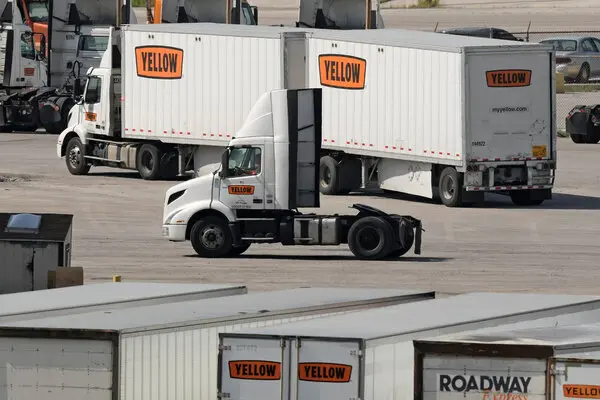
In 2025, the U.S. trucking industry is facing unprecedented turbulence. A rising number of carriers, from small owner-operator outfits to national logistics firms, are closing their doors due to economic pressures and tightening regulations. This increase in trucking company bankruptcies is not just a financial trend — it’s a warning sign for the supply chain, the labor market, and the broader economy.
The Economic Landscape Behind Carrier Collapse
The freight market has always been cyclical, but current conditions have created a perfect storm for trucking companies.
📉 Market Volatility and Freight Recession
Freight volumes have declined for several consecutive quarters, particularly in dry van and flatbed sectors. Soft demand combined with surplus trucking capacity has driven spot rates below profitable levels for many carriers. For businesses that scaled during the post-COVID boom, the current downturn has exposed unsustainable cost structures.
⛽ Inflationary Operating Costs
Diesel fuel remains one of the largest expenses in trucking, and volatile energy prices have eaten into already narrow margins. In addition to fuel, insurance premiums, compliance costs, and repair expenses have all risen sharply over the past two years.
📊 Tight Credit and Financing Pressure
Interest rate hikes have made it more expensive to lease or finance trucks and trailers. Lenders are also more selective, leaving smaller carriers without the cash flow cushion or credit access they need to survive downturns.
⚖️ Regulatory Strain
New compliance standards — including stricter emissions rules, expanded electronic logging requirements, and labor classification laws — have placed added pressure on fleet operators. For smaller carriers, staying compliant has become too costly.
Real-World Impact of Trucking Bankruptcies
The consequences of trucking company failures go far beyond the business itself. Here’s how the ripple effects play out:
1. Freight Delays and Lost Revenue
When a trucking firm shuts down, shipments are either delayed or abandoned mid-route. Manufacturers, distributors, and retailers depending on those deliveries can face production halts, inventory shortages, and contractual penalties.
2. Sudden Job Losses
Thousands of drivers, dispatchers, and warehouse personnel lose their jobs with little or no notice when a company files bankruptcy. Often, drivers are left stranded on the road, with no fuel cards or paycheck in sight.
3. Unpaid Debts and Supplier Disruption
Fuel providers, equipment lenders, software vendors, and maintenance shops often go unpaid when a carrier files Chapter 7 or Chapter 11. These unpaid obligations can cause financial stress for connected businesses.
4. Repossession and Equipment Auctions
When fleets default on loans, trucks and trailers are quickly repossessed and sent to auction. This floods the market with used equipment, driving down resale values and destabilizing lease markets.
5. Increased Costs for Surviving Carriers
Ironically, while capacity shrinks, operating costs for surviving carriers often go up. They face higher insurance premiums, increased maintenance on aging fleets, and difficulty scaling quickly to absorb new demand.
Legal Considerations When a Carrier Fails
When a trucking company files bankruptcy, whether under Chapter 7 (liquidation) or Chapter 11 (reorganization), several legal and financial processes unfold. Understanding them is key for affected stakeholders.
📄 Contract Cancellations
Shipping contracts, leases, and service agreements may be terminated by the court. Creditors and partners must act quickly to assess their exposure and reclaim property or payments due.
📝 Proof of Claim Filings
Vendors, contractors, and employees must submit formal claims to the bankruptcy court to seek payment. However, in many cases — especially under Chapter 7 — unsecured creditors receive little or no compensation.
🛠️ Asset Liquidation
For Chapter 7 cases, the bankruptcy trustee will liquidate company assets, including vehicles, office equipment, and accounts receivable. Proceeds are used to repay creditors in order of legal priority.
⚖️ Employee Wage Claims
Workers owed back pay may have a claim under federal law, but these are often capped and subject to court review. In sudden closures, drivers and office staff frequently face long waits and partial compensation.
Risk Mitigation for Businesses That Depend on Carriers
If your business relies on freight services, taking proactive steps can reduce the risk and fallout from carrier bankruptcy.
✅ Diversify Freight Providers
Avoid relying on a single trucking firm for all deliveries. Working with multiple regional and national carriers reduces the risk of disruption if one fails.
✅ Monitor Carrier Financial Health
Regularly assess the financial stability of logistics partners. Warning signs like delayed payments, equipment repossessions, or mass layoffs may indicate looming trouble.
✅ Secure Strong Contracts
Ensure your shipping agreements include clauses covering bankruptcy scenarios, freight recovery, and liability limits in the event of insolvency.
✅ Purchase Contingency Insurance
Consider cargo insurance or business interruption coverage that protects against financial losses caused by transport disruptions.
How Bankruptcy Attorneys Help Carriers in Crisis
For trucking company owners and operators, early legal advice can make a substantial difference in whether the business survives or dissolves.
A bankruptcy attorney with experience in transportation law can:
-
Analyze cash flow and debt structure
-
Recommend Chapter 11 reorganization or Chapter 7 liquidation
-
Guide contract renegotiation with lenders and vendors
-
Handle asset protection, tax obligations, and employee matters
-
Represent the company in court and trustee communications
In some cases, a legal team can help avoid bankruptcy entirely through out-of-court settlements or structured wind-downs.
Looking Forward: Adapting to a Changing Freight Market
While the recent rise in trucking company bankruptcies is troubling, it also signals a market correction. Many companies expanded rapidly during a short-term demand surge and are now paying the price for overleveraging.
The industry is likely to see:
-
Consolidation among carriers, with larger firms acquiring distressed assets
-
Technology-driven efficiencies to reduce overhead
-
Increased broker and 3PL reliance for scalable shipping solutions
-
Legal preparedness as a standard part of risk management


